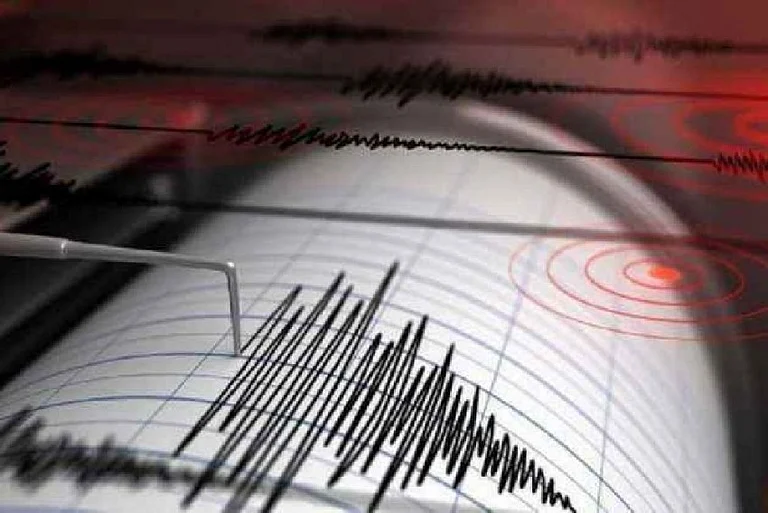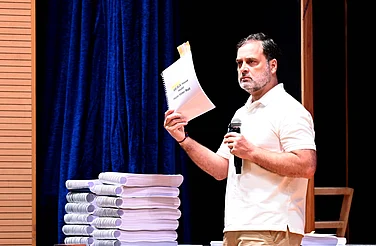Described as the ‘New Temple of Resurgent India’ by India’s first prime minister Pandit Jawaharlal Nehru, the Bhakra dam stands as a landmark in Independent India’s developmental history. Completed in 1963, the multi-purpose dam on the Sutlej River has tales to tell, not of prosperity as much as of despair.
More than half a century after the building of the 226-metre-high dam, nearly 11,777 families displaced from a total of 256 villages in Bilaspur, Hamirpur, and Una districts of Himachal Pradesh are still feeling the pain of displacement that includes the psychological impact of this displacement along with the submergence of fertile land in the absence of any rehabilitation policy — the kind of pain that is carried along by second and even third generations in families that faced the initial displacement.
Hoshiar Singh Thakur, one of the oustees of the Bhakra dam project, admits that nothing has come to the hands of the families who sacrificed their lands and settlements in the promise of prosperity and for the ‘green revolution’ in Punjab and Haryana.
A former vice-chairman of the zilla parishad (district-level panchayat) of Bilaspur district, Thakur says, “Governments changed and power rotated between the BJP and Congress during the past 50 years. Committees were formed to look into the issues of dam oustees but at least 500 to 600 families are still left to be rehabilitated or paid compensations.”
The township of Bilaspur which came up after water from the dam submerged Old Bilaspur along with vast tracts of land, approximately 1,06,77 acres of private land and another 20,515 acres of government land lack basic amenities. The demand for setting-up new sectors to accommodate the remaining 269 families still remains a contentious issue.
Pankaj Raj, the deputy commissioner of Bilaspur, recalls that 1,323 families were allotted plots in Bilaspur town until 2007 but the list continues to expand as another 118 families were later given plots on lease to build their residential houses.
“More than 269 cases are still pending for which 72 bighas (around 24 acres) of land is required. But there is no land available in the new Bilaspur township. A committee set-up by the government has identified a portion of land in the village Changer plasin. The process is underway to create plots,” says Raj.
However, the oustees allege a complete apathy from the government when it came to the question of their rehabilitation. Politicians, they allege, rendered only lip service and promised suitable cash compensations once Himachal Pradesh got its legitimate share of 7.19 per cent of the power generated from the Bhakra-Beas Management Board (BBMB) that has been pending since 1967 — the year the Punjab Reorganisation Act came to force.
Former Chief Minister Virbhadra Singh took the matter to the Supreme court in 1996. In 2011, the Supreme Court decided in favour of Himachal Pradesh, asking the BBMB, Punjab and Haryana governments to pay arrears to the tune of Rs 4,250 crore to Himachal Pradesh as compensation for its share of power generated at by the dam since 1966. However, no payments have been made to the state so far.
Former Congress minister Ram Lal Thakur, who has very frequently raised the issue of the rehabilitation of the oustees of the Bhakra project in the state assembly, argues that the protracted legal battle and the half-hearted efforts of the state government in providing justice to the displaced families has given more pain to the oustees than an understanding of their psyche.
“I believe those who got resettled in the new Bilaspur township still got a place to live but imagine the people in the villages. Their fertile lands got submerged. They abandoned their houses and lost livelihoods. Plots that they were allotted in Haryana in lieu of submerged lands were bought-over by influential businessmen and property leaders,” complains Thakur.
Vivek Chandel, 22, a third-generation oustee who runs a small fruit shop, alleges that his grandfather and father died waiting for compensation and rehabilitation.
“In 2015-16, I got eviction notices from the government after a High Court order was apparently issued to remove encroachers from forestland. The authorities cut water and electricity connections of at least 50 households, including mine. I am not sure how long our ordeal will continue,” says Chandel.
Ram Lal Thakur admits that it is a tragedy that the oustees of the Bhakra Dam project continue to live in tears in spite of his 37-year-long political struggle, including three ministerial tenures. Moreover, efforts of JP Nadda —a native of Bilaspur— served as Cabinet minister twice and is now the national president of the BJP and Union minister Anurag Thakur have also gone without any fruits so far.
As if this were not enough, more families in Bilaspur are now staring at displacement as land acquisition for the Bilaspur-Bhanupali railway line and the Kiratpur-Manali four-lane project has also begun, reminding them of the 58-year-old pain of evictions due to the Bhakra dam.


























